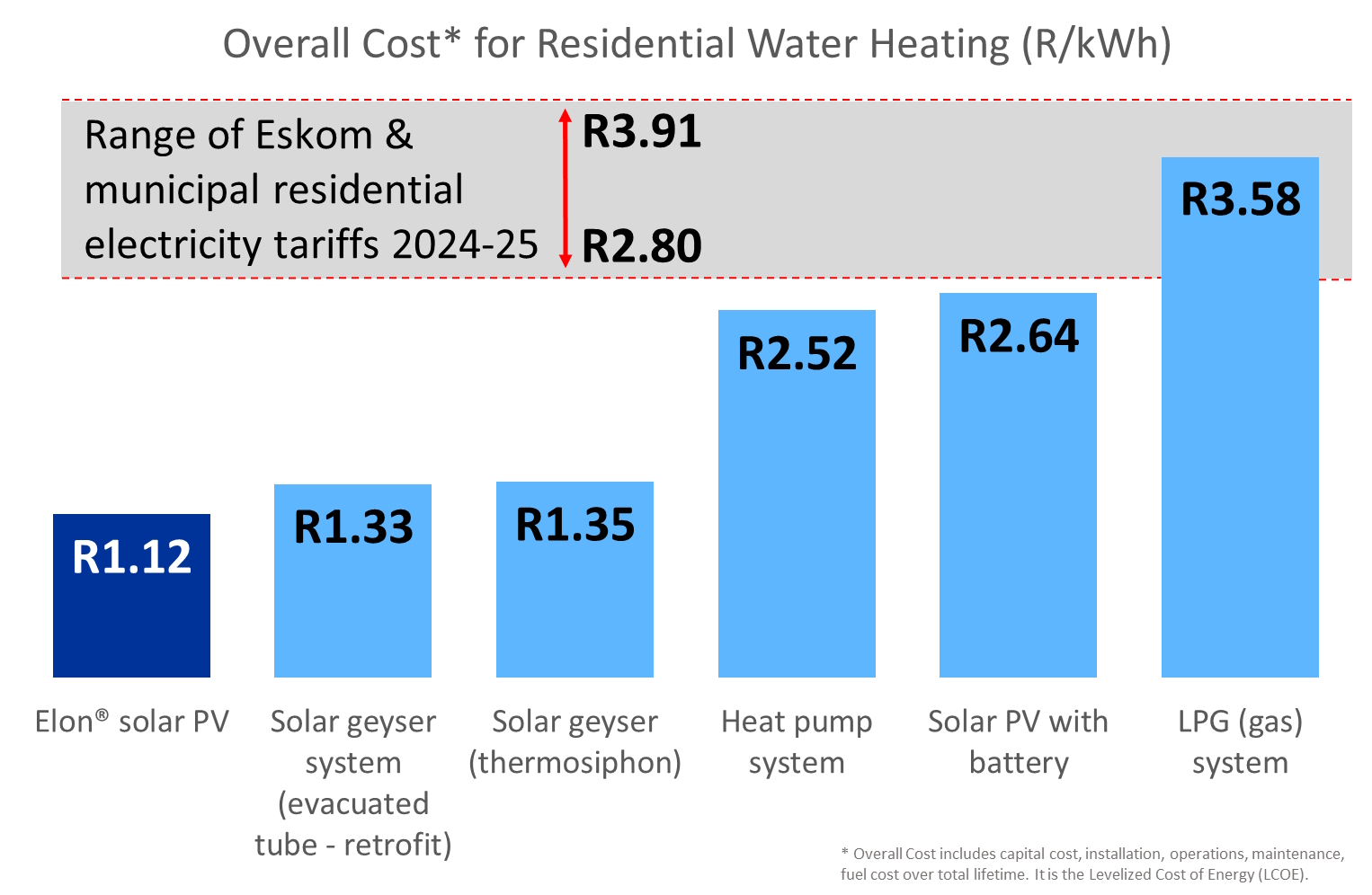PowerOptimal Elon® 100 Case Studies
Solar PV array size: 1.575 kWp Family size: 4 people Solar Fraction achieved: 52% of energy from the sun
When & Where: Pretoria, May 2017 (Winter)
Comments: With a system of less than 1.6 kWp for four people, over 50% of the family’s water heating energy was obtained from the sun in winter time.
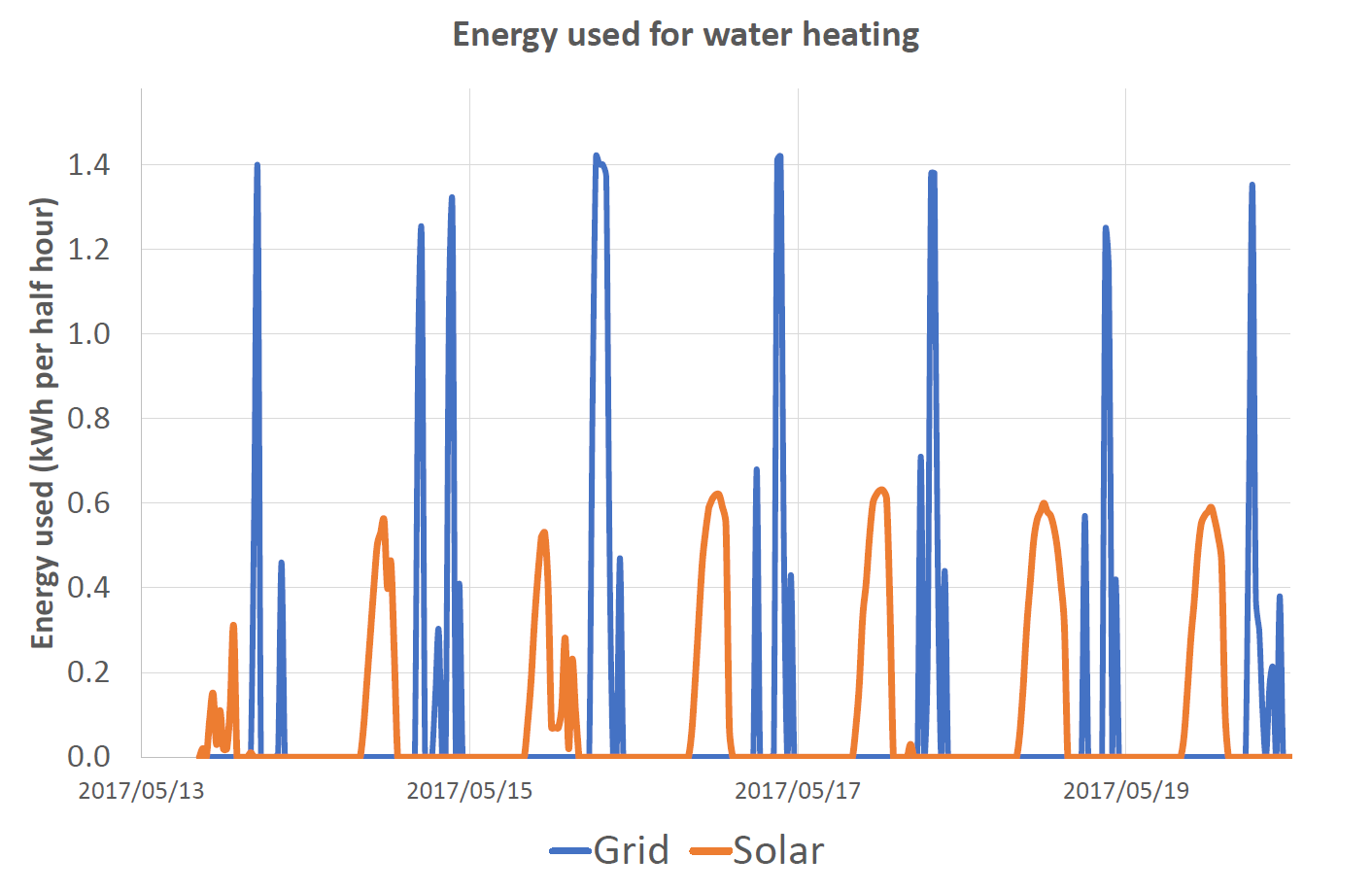 | 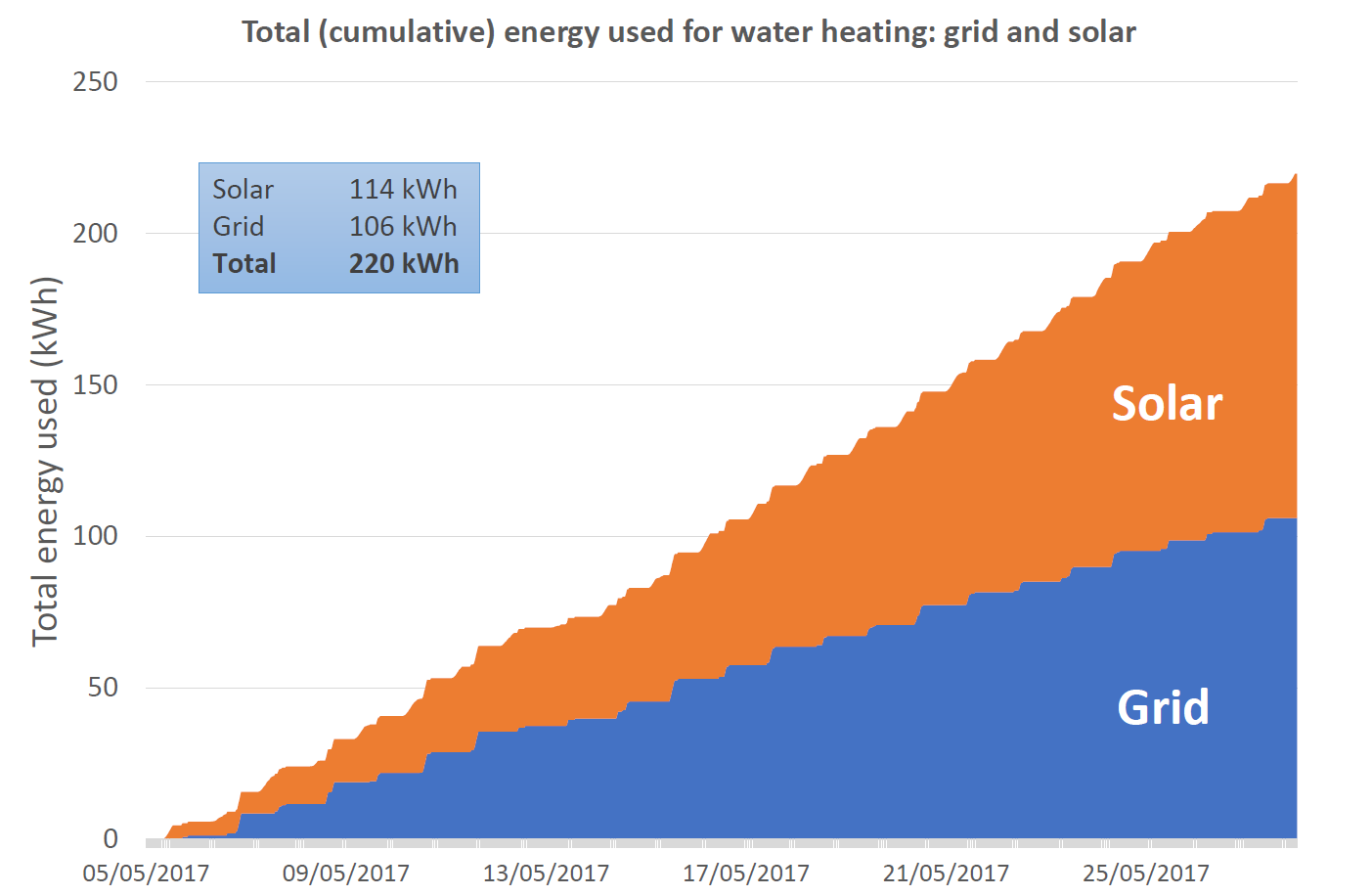 |
Solar PV array size: 1.5 kWp Family size: 2 people Solar Fraction achieved: 65% of energy from the sun
When & Where: Johannesburg, November to December 2017 (Summer)
Comments: Approximately two-thirds of this family’s water heating energy need was obtained from the sun.
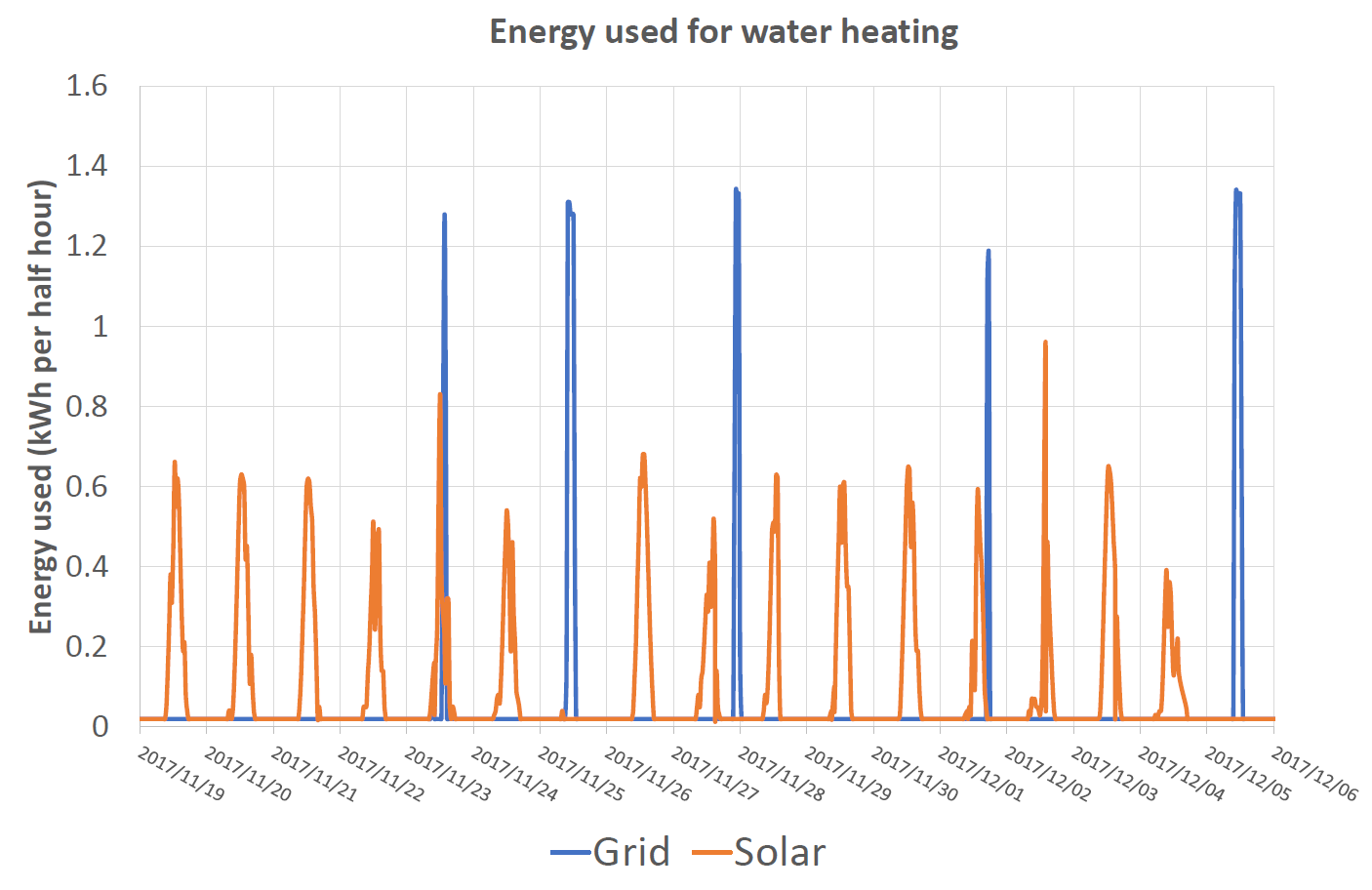 | 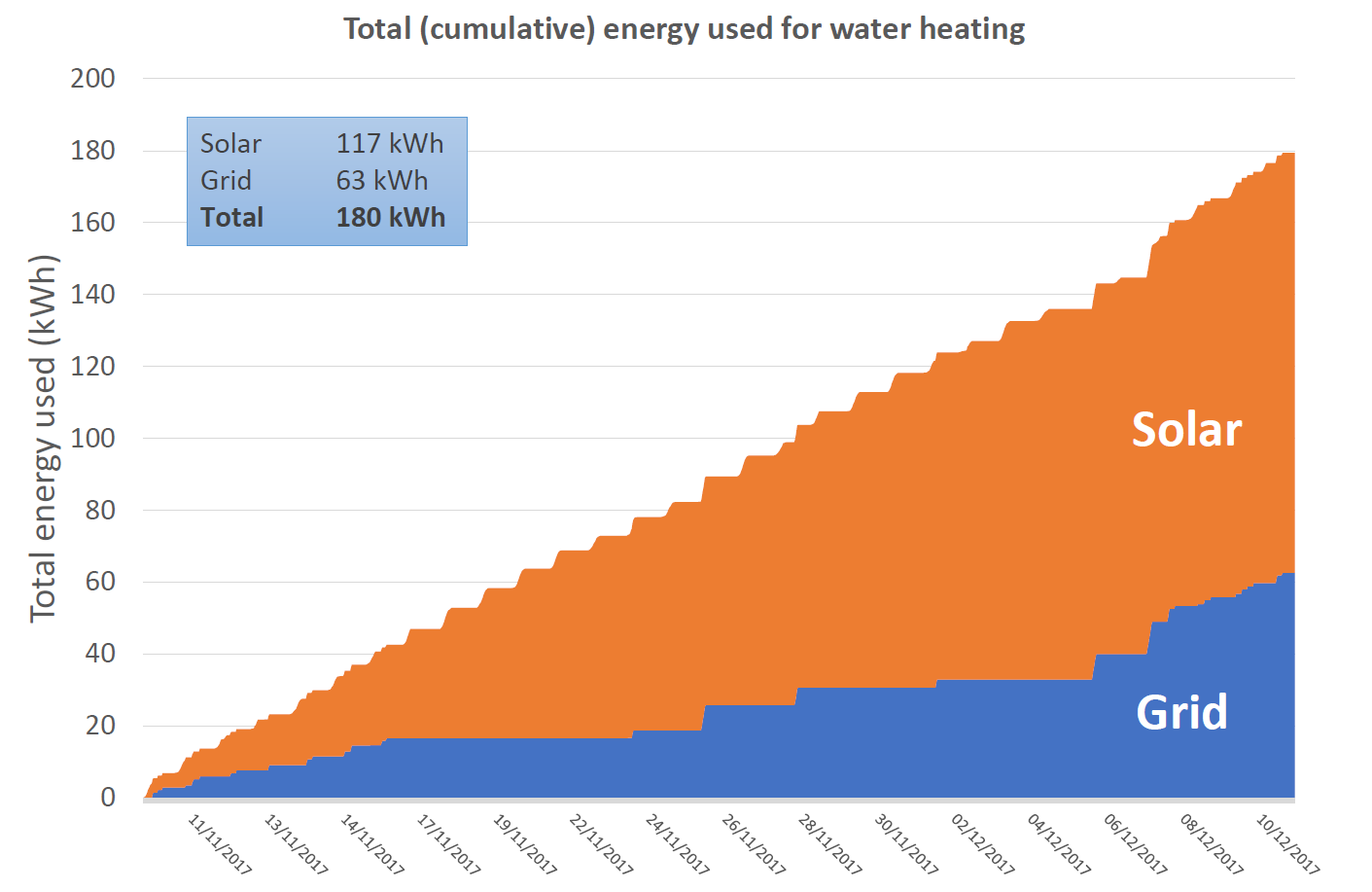 |
Solar PV array size: 1.8 kWp Family size: 1 person plus domestic worker Solar Fraction achieved: 99% of energy from the sun
When & Where: Cape Town, October 2020 to February 2021 (Summer)
Comments: All of this household’s water heating energy need was obtained from the sun.
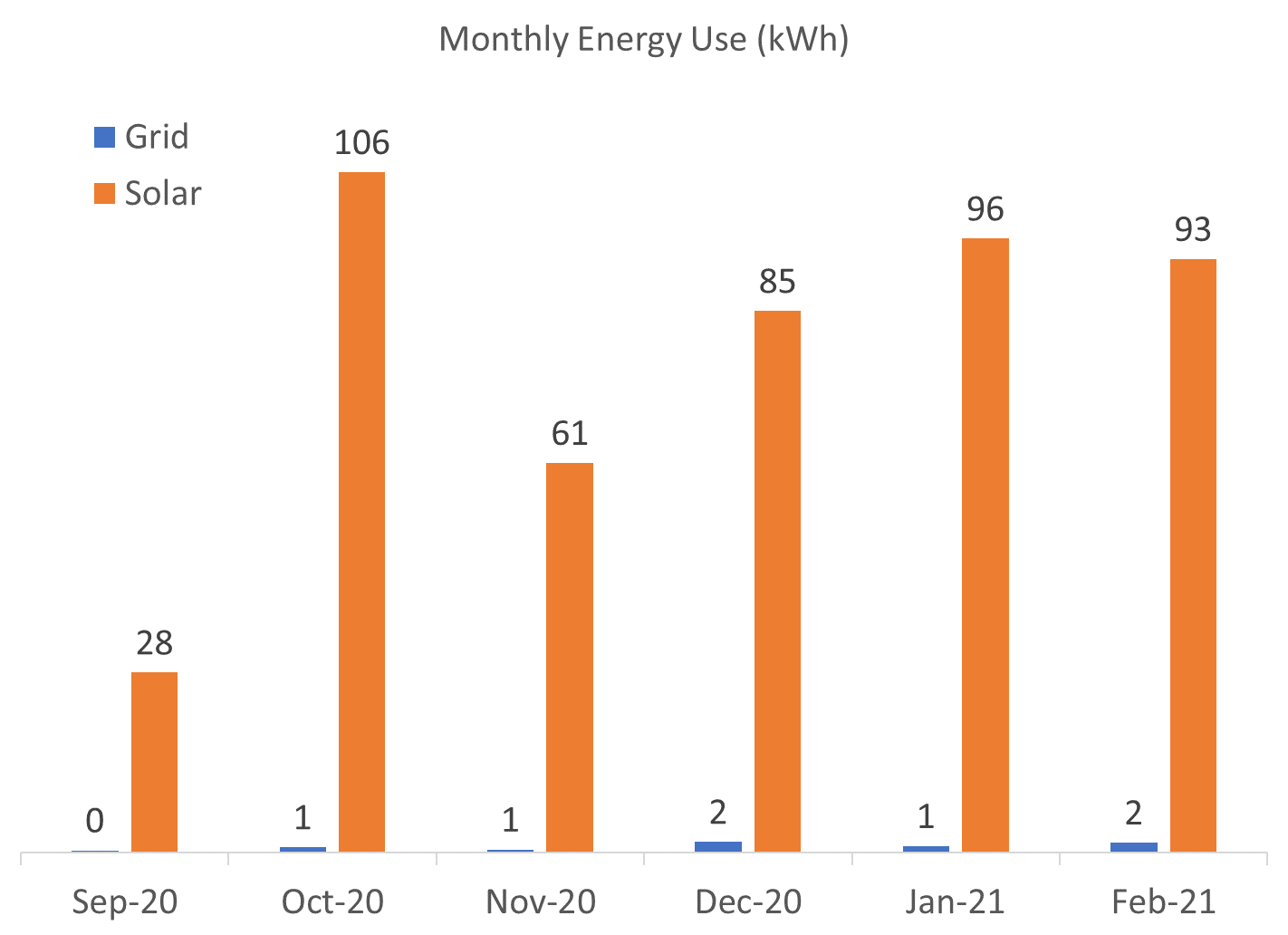 | 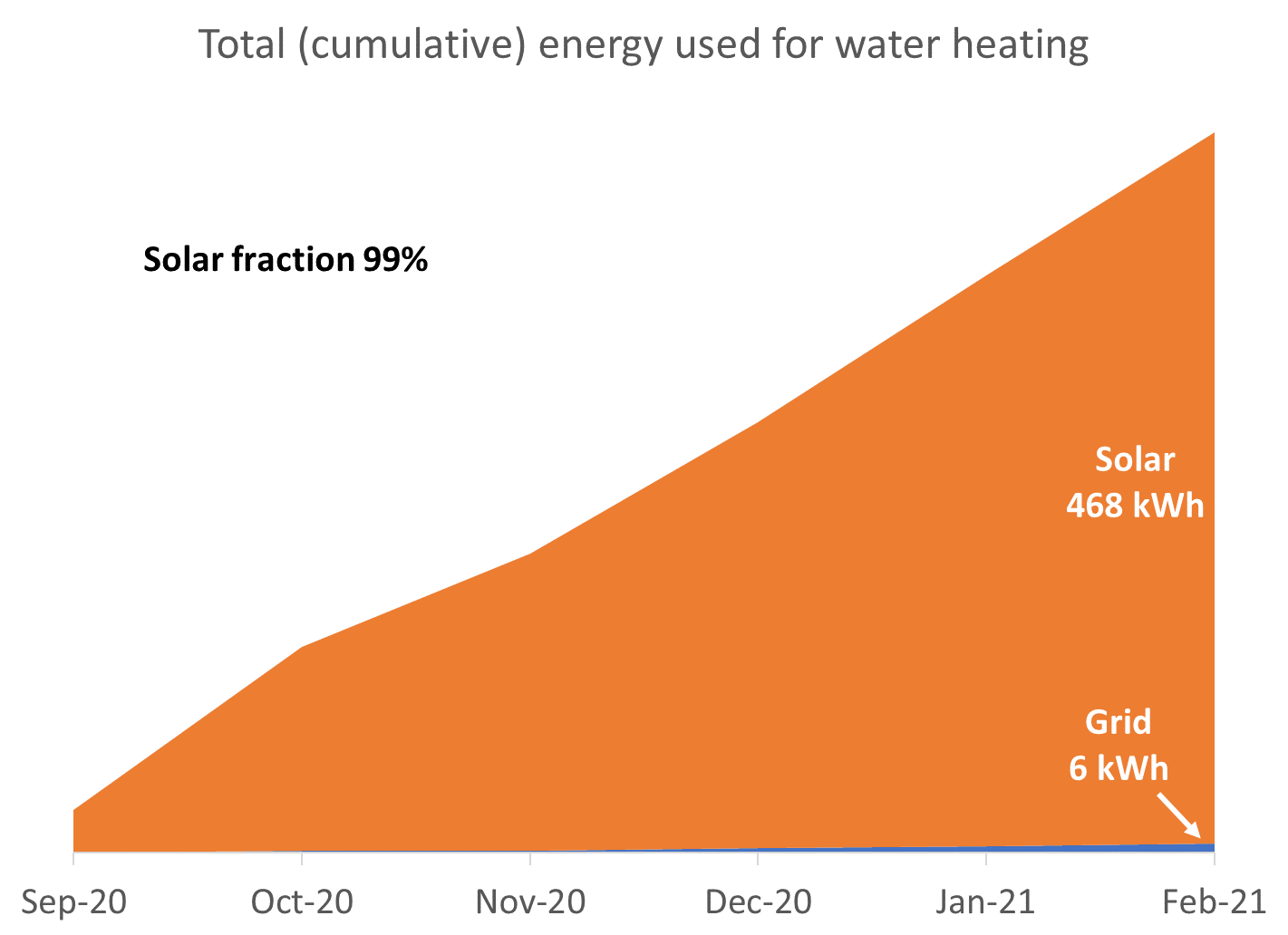 |
Solar PV array size: 1.5 kWp Family size: 1 person plus domestic worker Solar Fraction achieved: 78% of energy from the sun
When & Where: Johannesburg, May 2021 (Winter)
Comments: Over 75% of this household’s water heating requirements in winter was supplied by the sun.
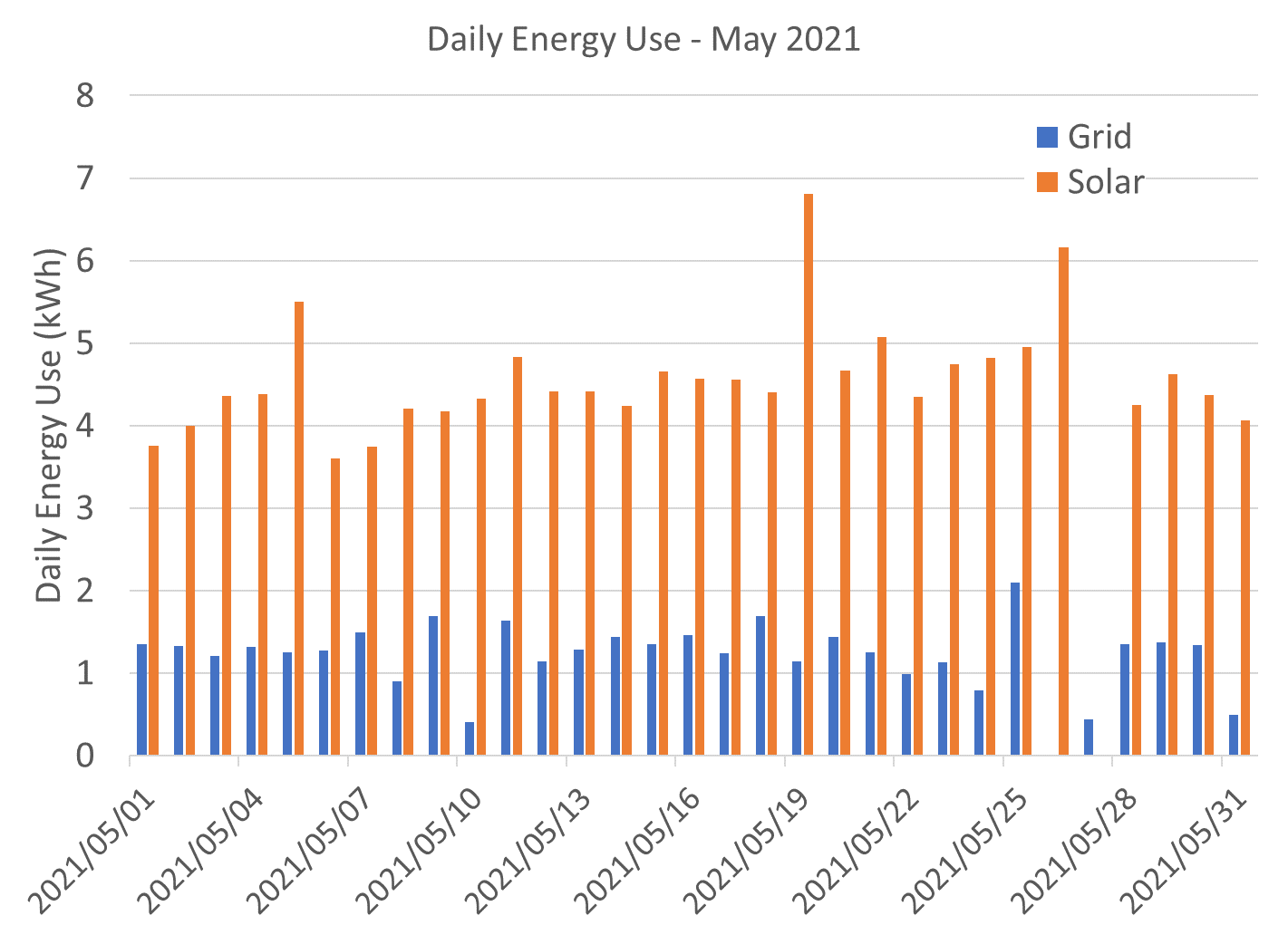 | 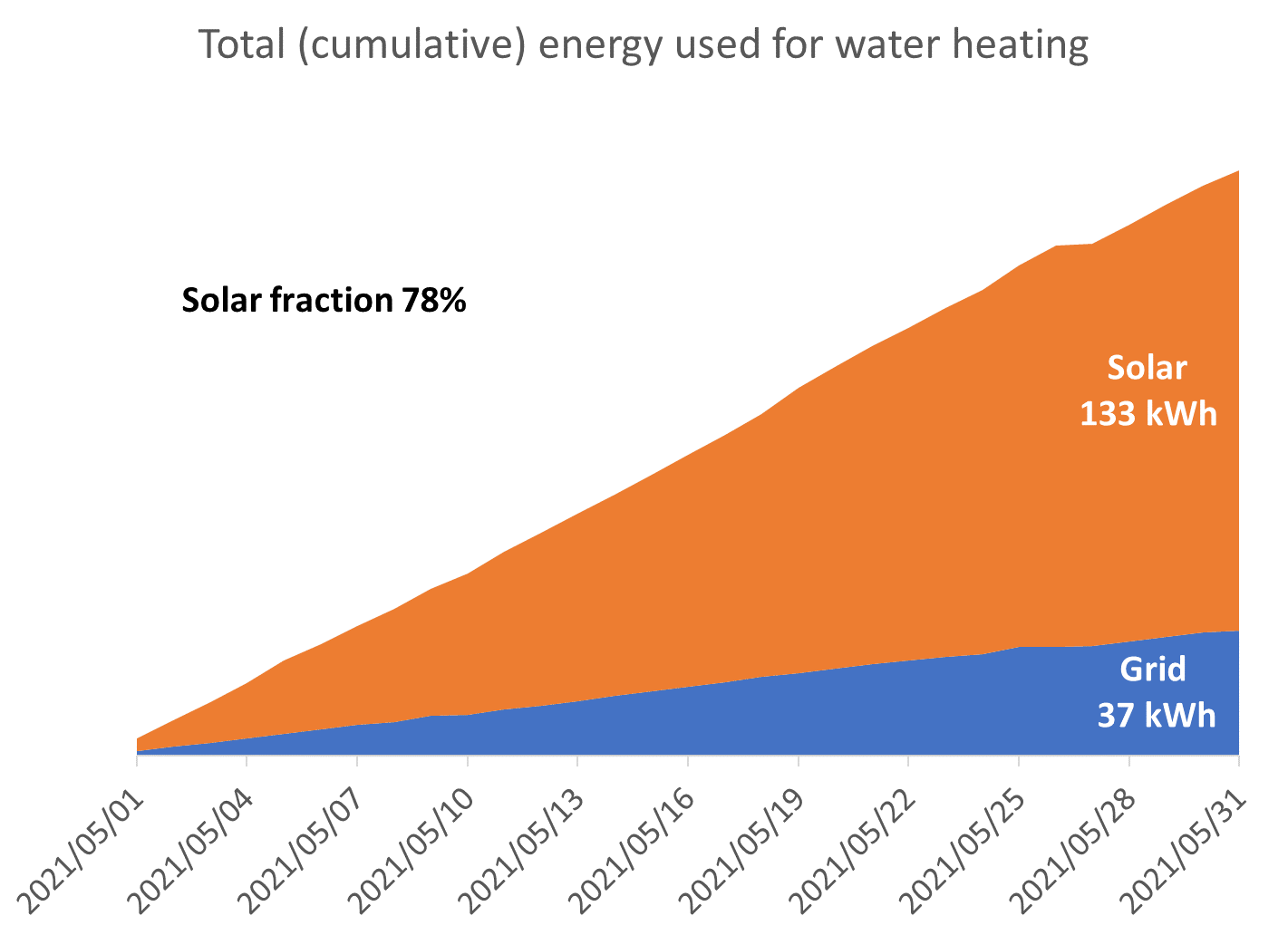 |
The size of the solar PV array (in other words, the number of solar PV modules on the roof) will directly impact the performance of the Elon® 100. Additionally, time of year and location will also have a substantial impact on system performance. Click here for a PDF with more information.
As can be seen from the graph below, payback period decreases as number of solar panels increases, and is also different for Johannesburg, Cape Town and Durban [1].
The reason that payback period improves (decreases) as number of solar panels increases, is because there are some fixed costs (such as engineering design & safety components) and some costs that do not scale linearly with array size (such as labour, wiring, mounting kit costs, etc.).
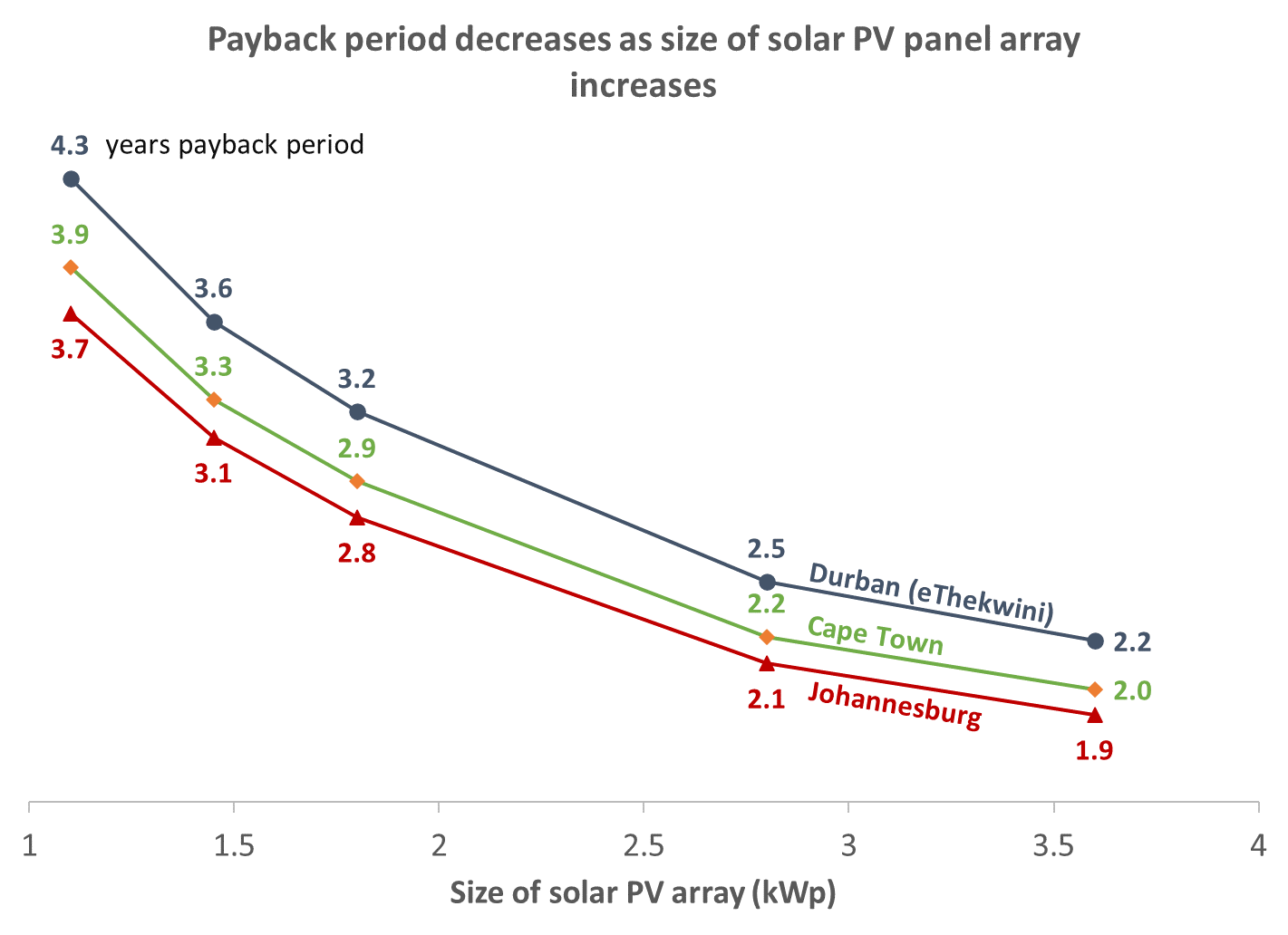
[1] Calculations based on actual Elon® performance, assuming a 20% reduction due to non-optimal user behaviour, an initial electricity tariff of R2.73/kWh (which is the 2021/2022 average residential tariff across the 4 major metropolitan areas Johannesburg, Cape Town, Tshwane and eThekwini) and an annual electricity price increase of 8%.
1. Background
The National Building Regulations in South Africa prescribe compliance with the SANS 10400-XA “Energy Usage in Buildings” Regulations. Part XA2 of these Regulations require all new residential and commercial buildings in South Africa to derive at least 50% of the energy they require for water heating from non-grid energy sources. These alternative sources include heat pumps, biogas, solar thermal and solar photovoltaic (or solar PV).
The question then arises: how does the cost of all these alternative water heating energy sources compare with that of grid electricity bought from a municipality in South Africa?
To compare energy sources with different initial (capital) cost, different lifespans and different operating & maintenance cost, a common approach used is the so-called Levelized Cost of Energy or LCOE. This approach considers all these different costs as well as the total lifespans to produce a single cost per unit of energy (kWh). This then enables direct comparison of different technologies and energy sources.
The PowerOptimal team has calculated the LCOE for several alternative energy sources and presents a summary of the results in this short document. See Appendix A for the basic methodology and inputs used.
2. Results
The following observations can be made from the above graph:
On a levelized cost of energy basis, the Elon® is the lowest cost per unit of energy of any of the options.
The highest cost option is buying electricity from the municipality and gas geysers.
Heat pumps continue to incur electricity cost and thus the heat pump energy cost will increase annually.
- LPG prices fluctuate depending on oil prices.
Eskom & municipal tariffs increase every year, whilst the effective lifetime cost per kWh for solar PV and solar thermal will remain at these calculated values for their respective lifetimes. It would be possible to finance such a system from a home loan or through solar financing and save more on electricity cost than the installment (in other words realise a net savings whilst incurring no capital cost).
In 2024/2025 the average marginal electricity tariff for lower to middle income households for the four largest metropolitan municipalities in South Africa (Cape Town, Tshwane, Johannesburg and eThekwini) is R3.47/kWh and for middle-upper income it is R3.98/kWh. This will increase again in July 2025.
Appendix A. Methodology and inputs
The LCOE can be calculated as [1]:
Here are the input values with sources as used in the calculations:
Description | Value | Units | Source |
Elon® annual solar PV energy production in Johannesburg | 1622 | kWh/kWp/year | Based on actual measurements |
Average Elon® energy utilization | 90% | The calculations for solar thermal were done with an assumption of 100% utilization of energy produced. Thus, this is a conservative assumption from a comparison perspective. | |
Elon® fully installed cost for a 1.41 kWp system | R26 000 | Incl. VAT | Typical actual cost |
Annual real electricity price increase | 8% | Estimate (Eskom average annual increase from 2008 to 2019 was 15.6% per year) | |
Average electricity price across four largest SA municipalities (Cape Town, Tshwane, Jhb & eThekwini) 2023-2024 | R3.12 | per kWh | Calculated from actual municipal electricity tariffs for 410 kWh usage per month. This is due to increase again in July 2024. |
Real weighted average cost of capital | 8% | per year | Yelland C. 2016. Understanding the cost of electricity from Medupi, Kusile and IPPs. Website: https://www.news24.com/fin24/Economy/Eskom/understanding-the-cost-of-electricity-from-medupi-kusile-and-ipps-20160721. Last accessed: 2020/06/24. |
Annual maintenance cost – Elon® | R100 | per year | There is no maintenance except cleaning the solar PV modules (which can be performed by the household), but this is included to be conservative. |
Annual solar PV panel performance degradation | 0.5% | per year | How long do solar panels last? Website: https://news.energysage.com/how-long-do-solar-panels-last/. Last accessed: 2020/06/24. |
Solar irradiance annual average Johannesburg | 5.46 | kWh/m²/day | Solar Electricity Handbook 2015 Edition. Website: http://solarelectricityhandbook.com/solar-irradiance.html. Last accessed: 2020/06/24. |
Solar thermal system energy production | 6.245 | kWh/day | For a 2 m2 system. Average of min & max performance from http://sessa.org.za/advice/solar-water-heating/solar-water-heating-basics. Last accessed: 24/04/2016. |
Typical cost of evacuated tube solar thermal system (installed) – retrofit (to existing solar-ready geyser) | R18 933 | Installed cost, incl. VAT | From: https://solar.co.za/product/solar-geyser-conversion-kit-15-tube-evacuated/ for a 15 EVT system. Last accessed: 2024/01/20. |
Typical cost of flat plate solar thermal system (installed) | R19 210 | installed cost, incl. VAT | 150 litre 400 kPa direct solar geyser, estimated installation cost R3000. From: https://www.sustainable.co.za/search?type=product&options[prefix]=last&q=thermosiphon*. Last accessed: 2024/01/20 |
Average annual maintenance cost (solar thermal) | R500 | per year | Estimate: estimated (UK: GBP120/2yr or R1200/yr) from http://www.yougen.co.uk/blog-entry/1765/Solar+Thermal+-+a+guide+to+life+expectancy+and+maintenance/. Last accessed: 2020/06/24. |
Lifetime of SA solar thermal systems | 12 | years | Estimate. (Typical warranty 5 years) |
Annual solar thermal system performance reduction | 1.5% | per year | Deterioration due to glass plate fogging and/or scaling. 63% reduction after 22 years: http://www.inive.org/members_area/medias/pdf/Inive%5CIBPSA%5CBS05_0247_254.pdf). 23 – 27% reduction after 18 years: https://backend.orbit.dtu.dk/ws/files/4035765/16%20Fan%20J.pdf. |
3.2 kW heat pump system price | R25 043 | installed cost, incl. VAT | R22 043 price for 3.2 kW domestic system: https://www.sustainable.co.za/collections/domestic-heat-pumps. Last accessed: 2024/01/20. Estimate R3000 for installation, piping and valves. |
Heat pump system annual maintenance cost | R500 | per year | Estimate for annual inspection & service. IOPSA reports an average 1-hour fee of R567.50 across South Africa. Website: https://www.iopsa.org/What-should-a-plumber-charge. Last accessed: 2020/10/15. |
Heat pump coefficient of performance (COP) | 3 | From: Zhang M. 2013. Performance of heat pumps in South Africa. Website: https://www.ee.co.za/wp-content/uploads/legacy/Energize_2013/09_at_01_performance-of-heat.pdf. Last accessed: 2020/06/24. | |
Heat pump system lifetime | 15 | years | From: http://www.tricountyheatingandcooling.com/home/heating_cooling_cincinnati/insights/post/20111101_whats_the_approximate_lifespan_of_a_heat-pump_system.html. Last accessed: 2020/06/24. |
Liquefied petroleum gas (LPG) Gauteng price | R37.53 | per kg | Price as of January 2024 (pre-COVID 19). Source: https://www.sapia.org.za/fuel-prices/. Last accessed: 2024/01/20. |
Gas geyser cost (installed) | R7 499 | installed cost, incl. VAT | 16L Alva gas geyser. Source: https://www.makro.co.za/home-garden/bathroom/plumbing/plumbing/geysers/alva-16-l-gas-water-heater/p/000000000000424792_EA. Last accessed: 2024/01/20. Estimate R3000 for installation. |
Gas geyser annual maintenance cost | R500 | per year | Estimate |
Solar PV with batteries residential LCOE | R2.64 | per kWh | Calculated. Based on fully installed price of 8 kW inverter, 4.3 kW solar PV array, 10 kWh lithium battery. Source: actual cost mid-2023. |
[1] Yelland C. 2016. Understanding the cost of electricity from Medupi, Kusile and IPPs. Website: https://www.news24.com/fin24/Economy/Eskom/understanding-the-cost-of-electricity-from-medupi-kusile-and-ipps-20160721. Last accessed: 2020/06/24.
